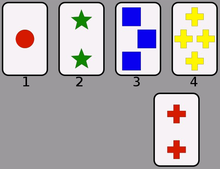- Cognitive flexibility
-
 Screenshot of computer based Wisconsin Card Sorting Test, a test used as a measure of cognitive flexibility.
Screenshot of computer based Wisconsin Card Sorting Test, a test used as a measure of cognitive flexibility.
Cognitive flexibility is the term used to describe one of the executive functions; a function which is an important component of human behavior; the ability to switch behavioral response according to the context of the situation. This ability of a person to see different aspects of an object, idea or situation and switch their "attentional set" is measured by such neuropsychological tests as the Wisconsin Card Sorting Test, and the Stroop test.[1]
Research has been conducted on the neural mechanisms underlying cognitive flexibility via the use of fMRI during test subjects completing a variety of set-shifting tests. Various distinct regions of the brain from which flexibility could be predicted reliably included the prefrontal cortex, basal ganglia, anterior cingulate cortex, and posterior parietal cortex.[2]
Diminished cognitive flexibilty has been noted in a variety of neuropsychiatric disorders such as Anorexia nervosa and in a subset of people with ADHD.[3][4]
Contents
Cognitive Remediation Therapy
Cognitive Remediation Therapy (CRT) is a cognitive rehabilitation therapy developed at King's College in London designed to improve various neurocognitive abilities such as executive functioning including cognitive flexibility. CRT has been shown via fMRI studies to effect a physiological change in different brain regions most notably the frontal cortex. CRT has been shown to have positive effect in various disorders such as schizophrenia, a condition in which cognitive flexibility is severely diminished.[5] as well as in anorexia nervosa[6][7][8]
Cognitive flexibility theory
Cognitive flexibility theory (CFT) proposes that individuals learn and grasp the nature of complex information more readily by being presented with multiple representations of the same information in varying contexts, e.g. the visual and auditory presentation of the information to be learned, such as seeing written text and hearing it. By observing multiple representations of the identical phenomenon the individual develops the neural pathways necessary for considering novel applications within the domain of available knowledge. The validity of CFT has been shown in neuroimaging studies utilizing PET scans.[9][10]
Cognitive flexibility hypertext
Cognitive flexibility hypertext (CFH) is a multimodal learning environment that was designed according to cognitive flexibility theory. CFH is based upon two basic premises (Spiro, 1996);
- That the majority of knowledge to be taught is complex and ill-structured
- Effective teaching remains a problem
"For learners to develop cognitively flexible processing skills and to acquire contentive knowledge structures which can support flexible cognitive processing, flexible learning environments are required which permit the same items of knowledge to be presented and learned in a variety of different ways and for a variety of different purposes (commensurate with their complex and irregular nature)." (Spiro, 1996)[11]
References
- ^ Zalonis I. et al. The stroop effect in Greek healthy population: normative data for the Stroop Neuropsychological Screening Test. Arch Clin Neuropsychol. 2009 Feb;24(1):81-8. Epub 12 March 2009.PMID 19395358
- ^ Leber AB, Turk-Browne NB, Chun MM. Neural predictors of moment-to-moment fluctuations in cognitive flexibility. Proc Natl Acad Sci U S A. 9 September 2008;105(36):13592-7. Epub 29 August 2008.PMID 18757744
- ^ Steinglass JE, Walsh BT, Stern Y. Set shifting deficit in anorexia nervosa.J Int Neuropsychol Soc. 2006 May;12(3):431-5 PMID 16903136
- ^ Etchepareborda MC, Mulas F.Rev Neurol.[Cognitive flexibility, an additional symptom of attention deficit hyperactivity disorder. Is it a therapeutically predictive element?][Article in Spanish]2004 Feb;38 Suppl 1:S97-102. PMID 15011162
- ^ Wykes T. et al.Effects on the brain of a psychological treatment: cognitive remediation therapy: functional magnetic resonance imaging in schizophrenia.Br J Psychiatry. 2002 Aug;181:144-52.PMID 12151286
- ^ Davies H, Tchanturia K. (2005) Cognitive Remediation Therapy as an intervention for acute Anorexia Nervosa: A Case Report. European Review of Eating Disorders. 13, 311-316
- ^ Tchanturia K, Davies H, Lopez C, Schmidt, U, Treasure J, Wykes T; (2008) Neuropsychological task performance before and after cognitive remediation in anorexia nervosa: A pilot case series Psychological Medicine 38(9):1371-3
- ^ Whitney J. Easter, A. Tchanturia K (2008) The patients experiences in cognitive exercise intervention for anorexia nervosa: Qualitative findings. International Journal of Eating Disorders 41(6):542-50
- ^ Comprehension instruction: research-based best practices By Cathy Collins Block, Lesley Mandel Morrow page 120,Publisher: The Guilford Press; Second Edition edition (April 22, 2008) Language: English ISBN 1593857004 ISBN 978-1593857004
- ^ Heath S, Higgs J, Ambruso DR.Evidence of knowledge acquisition in a cognitive flexibility-based computer learning environment.Med Educ Online. 3 December 2008;13:16.PMID 20165544
- ^ Coulson, R.L., P.J. Feltovich and R.J. Cognitive Flexibility Hypertext as a Learning Environment.
Categories:
Wikimedia Foundation. 2010.
